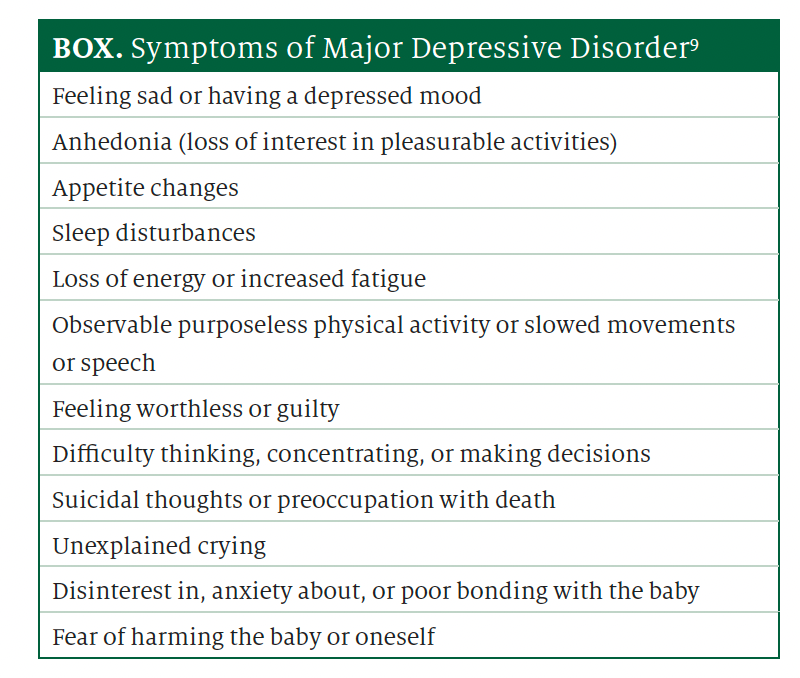Publication
Article
Pharmacy Times
Early, Appropriate Treatment for Postpartum Depression Can Help New Mothers
Author(s):
A variety of comorbid mood disorders often accompany this condition, including OCD and PTSD.
Pregnancy is usually happy news.1 But for some women, cultural stigmas, discrimination, socioeconomic concerns, and poorly understood biologic contributors associated with pregnancy trigger perinatal mood disorders during pregnancy and the year following childbirth.2,3 Women are at higher risk of depression or anxiety during the perinatal period than at any other time,4 and suicide in the first year after childbirth is a more common cause of death than postpartum hemorrhage or hypertensive disorders.4-6 Mood disorders can also have short- and long-term effects on the whole family.7
Tired Mother Suffering from experiencing postnatal depression | Image credit: Grooveriderz - stock.adobe.com

POSTPARTUM BLUES
Postpartum blues (“baby blues”), which are not considered a perinatal mood disorder, occur in up to 85% of patients during the first days after delivery.4,8
Affected women experience mild, nonimpairing dysfunction, which can include inexplicable crying, exhaustion, worrying, sadness, anxiety, mood swings, insomnia, headache, forgetfulness, poor concentration, appetite changes, negative feelings toward their baby, and irritability. Postpartum blues may be a manifestation of abrupt estrogen and progesterone withdrawal or a biologically programmed oxytocin effect. It is associated with the change from colostrum to mature milk and typically resolves within 2 weeks. Patients usually respond well to reassurance, emotional support, and exposure to their new way of life.9,10
POSTPARTUM DEPRESSION
If postpartum depression occurs, it usually develops 1 to 3 months after delivery but can occur anytime during the first year after delivery. Symptoms may start during pregnancy and magnify after delivery. Diagnosticians will find that postpartum depression is identical to other forms of major depressive disorder (Box9). If 5 symptoms are present daily for at least 2 weeks, postpartum depression is present.9
A variety of comorbid mood disorders often accompany postpartum depression, including postpartum anxiety, obsessive-compulsive disorder (OCD), and posttraumatic stress disorder (PTSD).
Postpartum anxiety typically presents within 3 months of delivery, with 75% of patients with postpartum depression also developing postpartum anxiety.11 Panic attacks or hypochondria may also develop, sometimes within just a few days of delivery, and up to 75% of patients who’ve had past episodes of OCD have a recurrence following childbirth that typically lasts for at least 6 months.12 Most women report obsessing about aggression and contamination and developing cleaning/washing and checking compulsions.13
PTSD appears to occur in approximately 10% of women after delivery, but if complications occurred during pregnancy or delivery, PTSD prevalence increases to roughly 30%.6 Clinicians should screen all patients for perinatal mood disorders at least once during the postpartum period and more frequently if they have risk factors.

NONPHARMACOLOGIC INTERVENTIONS
Treatment for postpartum depression is similar to that used in all depressive disorders but emphasizes collaborative care, family-focused interventions, therapy, and medication if necessary. Family-focused approaches benefit both parents. Prenatal and postpartum education classes; internet-based support groups; in-home visits from community health workers, nurses, or social workers; peer and breastfeeding support; parenting classes; and advice on exercise and diet can help.4,14
Cognitive behavioral therapy is the first-line therapy for perinatal depression.15,16 It trains patients to identify unhelpful ways of thinking, learned patterns of unhelpful behavior, and coping mechanisms,17 and it is often as effective as medication.15,16 Time-limited, focused interpersonal therapy is also effective for perinatal mood disorders.18
PHARMACOLOGIC MANAGEMENT
If nonpharmacologic interventions are unsuccessful, most guidelines recommend starting a selective serotonin reuptake inhibitor (SSRI) rather than polytherapy to limit risks. If the patient has taken an SSRI successfully in the past, the provider should prescribe that same medication.19 Providers must work with patients and discuss risks and benefits.
The FDA revised the Pregnancy and Lactation Labeling Rule in 2015, and labeling now provides clinical summaries, comprehensive risk/benefit information, data on clinical experience, animal data, and risks of untreated illness.20 SSRI use during pregnancy does not appear to increase risk of major congenital malformations. One study found a low absolute risk of preeclampsia, postpartum hemorrhage, preterm delivery, persistent pulmonary hypertension of the newborn, and neonatal intensive care unit admissions.21 However, a large cohort study of more than 100,000 pregnant women with depression did not link SSRIs and preeclampsia, but it did link using SSRIs or tricyclic antidepressants as monotherapy during pregnancy with preeclampsia.22 A later meta-analysis of women taking SSRIs showed that risk of preterm birth was insignificant when compared with women with untreated perinatal depression.23
Preferred SSRIs in pregnancy are citalopram (Celexa), escitalopram (Lexapro), fluoxetine (Prozac), and sertraline (Zoloft) because of low risk of birth defects. Paroxetine (Paxil) is not recommended in pregnancy because of risk of cardiac malformations.24
In 2019, the FDA approved the first medication specifically for postpartum depression, brexanolone (Zulresso).25 Three clinical trials established this intravenous medication’s efficacy and safety.26 Due to potential serious risks, it is only available through the Risk Evaluation and Mitigation Strategy program. Patients can receive brexanolone at health care facilities equipped to monitor them for 60 continuous hours while receiving the drug by intravenous infusion.
CONCLUSION
Postpartum depression is a serious concern. Frequent screening and early treatment can ensure mom and baby thrive. Pharmacists can leverage not only their medication expertise, but also their close relationships and frequent interactions with patients, to screen for and help manage postpartum mood disorders.
ABOUT THE AUTHOR
Jeannette Y. Wick, MBA, RPh, FASCP, is the director of the Office of Pharmacy Professional Development at the University of Connecticut in Storrs.






